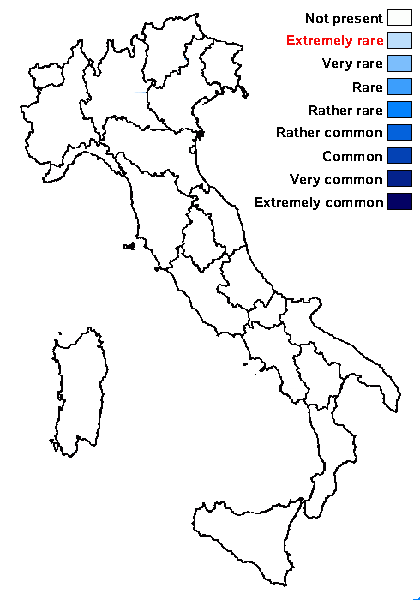Thelidium rehmii Zschacke
Hedwigia, 62: 116, 1920.
Synonyms:
Distribution:
Description: Thallus crustose, thinly episubstratic, continuous to finely rimose, grey-white to olive-green, subgelatinous when wet, proso- or paraplectenchymatous, ecorticate, without a dark basal layer; photobiont cells irregularly arranged. Perithecia scattered, black, 0.2-0.3 mm across, forming hemispherical projections. Involucrellum absent; exciple globose, black and thicker in upper part, pale brown to colourless in lowermost part; hamathecium of up to 30 µm long periphyses and periphysoids, interascal filaments absent; hymenial gel I+ red (I+ blue at very low concentrations of I), K/I+ blue. Asci 8-spored, ellipsoid to clavate, I-, fissitunicate, the wall thickened above, with an ocular chamber, dehiscent by extrusion of a delicate rostrum,67-93 x 26-40 µm. Ascospores 1-septate, hyaline, ellipsoid, (13-)21-28(-31) x (7-)9-13(-15) μm. Photobiont chlorococcoid. Spot tests: K-, C-, KC-, P-, UV-. Chemistry: without lichen substances.
Note: on sandstone and siliceous schists in humid situations, at low elevations; rare throughout Central Europe, with several scattered records from the Eastern Alps, outside the Italian territory; to be looked for in the Italian Alps.
Growth form: Crustose
Substrata: rocks
Photobiont: green algae other than Trentepohlia
Reproductive strategy: mainly sexual
Poorly known taxon in need of further study

Predictive model
Growth form: Crustose
Substrata: rocks
Photobiont: green algae other than Trentepohlia
Reproductive strategy: mainly sexual
Poorly known taxon in need of further study

Predictive model
 INDEX FUNGORUM
INDEX FUNGORUM
 GBIF
GBIF


